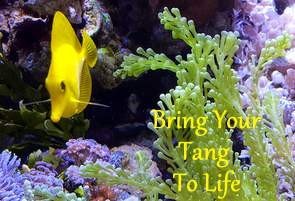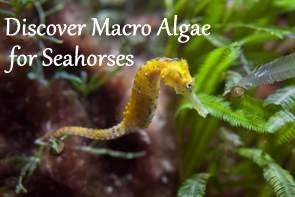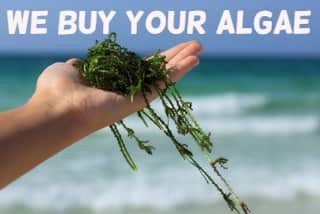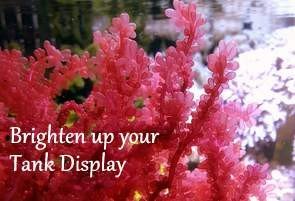Best water conditions for macroalgae growth in the display tank / refugium
For a marine macroalgae tank we recommend the following water parameters:
This is a general rule, which is valid for most macroalgae species we offer for sale, but there will be some species which will need a different environment. If you are unsure please ask us before you order live algae species from us.
Temperature: Between 23-28 °C ( A higher temperature will stress most macroalgae species and can damage them )
PH: 8-8.4
Alkalinity: 8-11
Salinity: 1.024 - 1.026
Nitrate: Between 3-10 ppm, minimum 2ppm
Phosphate: Below 0.5 ppm, good is 0,03 ppm, minimum 0.02ppm
Magnesium: Around 1200 ppm - 1350 ppm
Calcium: Around 400 ppm - 450 ppm ( high levels are important for calcified species like Halimeda)
Iron: Around 0.01 ppm
Iodine: around 0.04 ppm
With the right water conditions you will find it quite easy to keep macroalgae successfully in your own Marine Aquarium Display Tank or Refugium / Sump and enjoy them watching growing and transforming you Marine Aquarium in a beautiful Planted Fish or Seahorse Tank or Planted Reef Aquarium together with Soft & Hard Corals.
Although macroalgae are not plants they will need almost the same essential elements like plants and beside the of course the very important factor of the correct lighting (which we cover in another post ) they will need the right water parameters for macroalgae and some major and minor minerals to grow well and stay healthy.
Opposite to plants macroalgae don't grow with roots and therefore the nutrients need to be supplied through the water and not through the substrate ( like Freshwater aquarium plants which can be fed by fertiliser through the substrate).
The amount of minerals they need to grow well will of course vary with the macroalgae you keep in your marine aquarium, how often you do saltwater changes and what kind of livestock you keep in the aquarium.
You have just a few macroalgae species in your reef display tank or refugium ?
When you have just a few macroalgae species in your marine aquarium you normally can take it quite easy and just enjoy the time watching them growing as you will be normally fine with regular water changes. Together with the presence of livestock like fishes or Seahorses, which often will provide enough nutrients for a good macroalgae growth.
The most important nutrients for macroalgae to grow are Nitrate and Phosphate. Which means you will have a good start already when you have measurable Nitrate of over 2 ppm and Phosphate of around 0.02 ppm . But have in mind when thinking about chemical Nitrate and Phosphate remover in the marine aquarium that those chemical nutrients remover will take out the nutrients which is the most important "food" source for the macroalgae to grow and thrive.
Which means that you will let the macroalgae starve by using those chemical remover. It can be so helpful to get the nitrate & phosphate back into a normal range, when they are way to high. Just have in mind that you do not let the nitrate concentration sink below 2 ppm and the phosphate concentration below 0.02 ppm.
You have some more macroalgae species in your reef display tank or refugium?
That is perfect and you are not alone with that :)
Macroalgae are just to fantastic to enjoy them in the planted marine aquarium tank. Especially some beautiful Gracilaria macroalgae species add such a fantastic colour to the reef tank (and of course they clean too the marine water by lowering your Nitrate & Phosphate level whilst growing ).
But of course the fast growing macroalgae species like Chaetomorpha or Caulerpa are just perfect to do the big nutrient export job in your refugium / sump, but as they grow faster the available nutrients will be faster limited with normal water changes.
Whatever it is what got you deeper into the beautiful world of marine macroalgae, when you have some more species in your planted tank, or very fast growing macroalgae species you may want to have a look into adding some major or minor minerals in addition to your water changes to improve the growth of your macroalgae and to keep them healthy.
It is important to keep especially an eye on the Nitrate and Phosphate levels, as those are the marin nutrients macroalgae will need to grow. We recommend at least o have a Nitrate concentration of 2ppm and a Phosphate concentration of 0,02ppm.
Macroalgae will not thrive well in an environment without or very little Nitrate and Phosphate, or where Nitrate and Phosphate remover as used as they will take out the key nutrients macroalgae need to grow and thrive.
Beside the major nutrients Nitrate and Phosphate they will need some minor nutrients like Iron, Sulfate, Biotin, Manganese and Iodine, which will normally be added with your regular water changes. Having more macroalgae species in your Display Tank or Refugium / Sump will make it necessary to add some of the following minerals.
Please note:
The following list shows major and minor nutrients which macroalgae will need to grow successfully in a marine aquarium.
Always be careful on what and how much nutrients you add into your marine aquarium, as it might harm fishes, invertebrates or corals when used incorrectly.
We can not take any responsibility for this!
If you have any questions or if you would like to know more about this please contact us.
Main Nutrients for macroalgae in a planted reef tank / macroalgae refugium
The most important nutrients for a great growth in a marine aquarium through photosynthesis are Nitrate, Phosphate, Magnesium, Potassium, Calcium, Sulphur and Carbon.
Nitrate
Nitrate is by far the most important mineral for macroalgae to grow.
In the marine aquarium Nitrate if normally enough available, due to the nitrogen cycle and the waste from livestock, eg. Fish and Seahorses.
In fact, often the nitrate levels in marine tanks are so high, that it leads aquarists to think about the use of macroalgae, whilst looking for a natural way to reduce the Nitrate level in the marine water, often called Nutrients export.
In a marine aquarium with soft coral and/or fishes, it is normally not a problem to have a Nitrate Level between 5-10 ppm.
Whilst reef tank owners with hard corals will aim for a much lower nitrate level so that it is almost just available in traces.
Often macroalgae will be used in that case just to keep the nitrate levels very low, which will cause a slower growth of the macroalgae. In Reef Tanks with very low Nitrate level we do not recommend some Caulerpa species, as they might starve and not do well. Much better will do some medium fast growing macroalgae like our Thick Chaeto, which is very stable and good with periods of very low nitrate levels.
When your Nitrate Level is too low because you have a Planted Reef Tank, Planted Refugium / Sump you might need to add Nitrate to your water.
We add regular CaNO3 ( Calcium Nitrate ) to maintain a Nitrate Level of 5 ppm but another good way to add Nitrate would be KNO3 ( Potassium Nitrate ).
Phosphorus
Phosphorus is the second main mineral for healthy macroalgae growth.
Phosphorus is often enough available in the form of Phosphate PO4. Phosphate will be mainly introduced into the marine aquarium with fish food like flakes and especially frozen food blocks, but as well through detritus and fish waste.
Macroalgae will need much less phosphate than Nitrate for its growth, therefore a Phosphate Level below 0.05 is enough to keep macroalgae successful in the Display Tank / Refugium.
Please note that even the often recommended Phosphate level for a marine aquarium of around 0.03 ppm is enough with just a few macroalgae species in it.
This lower Phosphate level is recommended especially when hard corals are kept, as a higher level will negatively affect the coral growth.
If you run very low levels on Phosphate in aquarium a good source for Phosphorus is KH2PO4 ( Monopotassium Phosphate )
Magnesium
Magnesium will be often sufficient enough available in the marine aquarium, as it will be replaced with saltwater changes.
In heavily planted marine tanks it might be necessary to add magnesium to maintain a Magnesium level around 1250-1350 ppm
A good source for Magnesium is MgSO4x7H2O ( Magnesium Sulfate )
Calcium
Calcium is again another important element for good macroalgae growth. Especially calcareous macroalgae species like from the Halimeda family will need a higher calcium level for its growth.
Calcium can't be easily added to the marine aquarium like other nutrients/elements, as the available calcium in the marine water depends and influences directly with the Alkalinity and PH Level of the marine water. but there are readily mixed solutions available which will keep that balance intact by increasing the Calcium level.
We use Calcium reactors to maintain a good calcium level of around 430 ppm but normally macroalgae will be fine with a calcium level in a range between 380-450 ppm.
As mentioned before adding Calcium alone to the marine water will affect your PH and Alkalinity levels. For macroalgae, it is recommended to keep the Alkalinity between 7-10 DKH, and the PH Level between 8-8,4.
Potassium
Potassium is another important nutrient for the marine< macroalgae. It will be commonly sufficiently available in the marine water as it will be replaced by saltwater changes
( Please check the salt used, that it includes Potassium ).
Sulphur
Quite important too is Sulphur, which is normally though sufficient enough available as it will be replaced with water changes.
Carbon
Last but not least macroalgae will need carbon for its growth, which will be turned into oxygen. Carbon will be sufficient enough available in most marine aquariums and the produced oxygen will be helpful when the marine aquarium inhabits a lot of fishes.
In planted marine Aquarium / Refugium it may be necessary to add Carbon for example with a CO2 reactor.
Minor Nutrients for macroalgae in a planted reef tank / macroalgae refugium
Beside the major nutrients mentioned above, macroalgae will need some minor nutrients to allow a healthy growth and development.
Sometimes these nutrients are often referred to as trace elements.
As for major nutrients, it won't be necessary to add any of those Nutrients/Elements to a marine or reef aquarium with just a few macroalgae species in it.
Just in heavily planted marine aquarium setups, it might be necessary to add some of them periodically.
We add to our macroalgae tanks mainly the following minor nutrients:
Iron
Especially in heavily planted reef tanks / planted refugiums it might be necessary to add Iron. There are a few ready mixed Iron solutions available, which are specially made for marine aquariums. Be careful with normal Iron Solutions, as they might include Nutrients/Elements, which can be harmful to the marine aquarium inhabitants.
We use Ferrion, which is a concentrated Iron supplement for all marine fish and reef aquaria.
There are ongoing discussions about what Iron level should be maintained. We have actually good experiences with an Iron level between 0.05-0,1 ppm.
Iodine
Like with the supplement of Iron there are ongoing discussions about the benefits of adding Iodine to the water.
We actually add one drop per 100l every couple of days to our macroalgae tanks and have good results with that. Especially Red and Brown Macroalgae species are believed to grow better with it.
Vitamin B12
Very rarely do we add some Vitamin B12 to our tanks, and just in very low amounts, as we notice a microalgae bloom when too much gets added.
Other minor Nutrients are as well necessary for the growth of macroalgae, but they are normally sufficiently replaced by water changes.
These are:
Manganese, Copper, Molybdenum, Zinc and Boron

























































 Current Delivery Delays Due To Storm Darcy
Current Delivery Delays Due To Storm Darcy  Christmas break for our macroalgae species.
Christmas break for our macroalgae species.  Red macroalgae species for the Reef Display Tank
Red macroalgae species for the Reef Display Tank